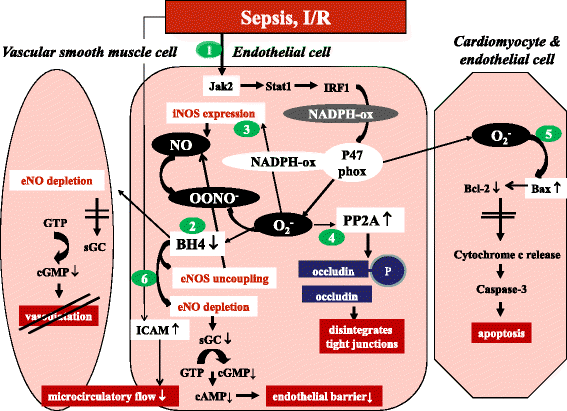Vitamin C revisited
- PMID: 25185110
- PMCID: PMC4423646
- DOI: 10.1186/s13054-014-0460-x
Vitamin C revisited
Abstract
This narrative review summarizes the role of vitamin C in mitigating oxidative injury-induced microcirculatory impairment and associated organ failure in ischemia/reperfusion or sepsis. Preclinical studies show that high-dose vitamin C can prevent or restore microcirculatory flow impairment by inhibiting activation of nicotinamide adenine dinucleotide phosphate-oxidase and inducible nitric oxide synthase, augmenting tetrahydrobiopterin, preventing uncoupling of oxidative phosphorylation, and decreasing the formation of superoxide and peroxynitrite, and by directly scavenging superoxide. Vitamin C can additionally restore vascular responsiveness to vasoconstrictors, preserve endothelial barrier by maintaining cyclic guanylate phosphatase and occludin phosphorylation and preventing apoptosis. Finally, high-dose vitamin C can augment antibacterial defense. These protective effects against overwhelming oxidative stress due to ischemia/reperfusion, sepsis or burn seems to mitigate organ injury and dysfunction, and promote recovery after cardiac revascularization and in critically ill patients, in the latter partially in combination with other antioxidants. Of note, several questions remain to be solved, including optimal dose, timing and combination of vitamin C with other antioxidants. The combination obviously offers a synergistic effect and seems reasonable during sustained critical illness. High-dose vitamin C, however, provides a cheap, strong and multifaceted antioxidant, especially robust for resuscitation of the circulation. Vitamin C given as early as possible after the injurious event, or before if feasible, seems most effective. The latter could be considered at the start of cardiac surgery, organ transplant or major gastrointestinal surgery. Preoperative supplementation should consider the inhibiting effect of vitamin C on ischemic preconditioning. In critically ill patients, future research should focus on the use of short-term high-dose intravenous vitamin C as a resuscitation drug, to intervene as early as possible in the oxidant cascade in order to optimize macrocirculation and microcirculation and limit cellular injury.
Figures

Comment in
-
There's life in the old dog yet: vitamin C as a therapeutic option in endothelial dysfunction.Crit Care. 2014 Aug 27;18(4):461. doi: 10.1186/s13054-014-0461-9. Crit Care. 2014. PMID: 25184406 Free PMC article.
References
-
- van den Berg BM, Nieuwdorp M, Stroes ES, Vink H. Glycocalyx and endothelial (dys)function: from mice to men. Pharmacol Rep. 2006;58:75–80. - PubMed
Publication types
MeSH terms
Substances
LinkOut - more resources
Full Text Sources
Other Literature Sources
Medical

